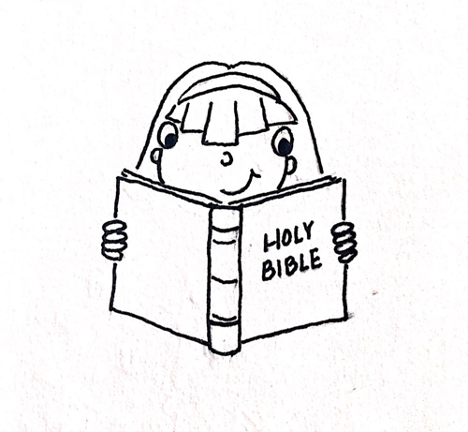Life to Lessons: Just Read it!
/in LivingEd - YouthEstimated Reading Time: 1 min. 20 sec.
Ever feel overwhelmed by the amount of information you receive regarding ways to teach your children the Bible?
Many books, websites, blogs, and videos offer their advice, tips, and tools. There are many ideas out there, and many can be very useful and helpful. But don’t get caught up in the idea that having the perfect activities, or the best teaching style is going to be what trains your children to love the Bible.

It’s only been in the past few decades that people have had access to the activities, supplemental materials, and research in child psychology that is available today. Since many young people have grown up to love God and His inspired Word without these extra tools, they cannot not be the primary reason for it. So don’t over-complicate teaching God’s word.
Simply reading the Bible out loud to your children, just as it is written, is one of the best ways to ensure that your children are receiving God’s word in a wholesome way.
You don’t have to add a lot of activities or have access to the cutest Bible coloring pages. Just read the Bible as God wrote it. Reading it out loud to your children every day will help them build good habits of Bible study, and impress upon them that there is no substitution for God’s Book–which, quite honestly, is perfect just the way it is.
Digging Deeper: Apple of His Eye
/in LivingEd - Online LearningAuthor: Mr. Kenneth Frank | Faculty in Theology, Living Education
Estimated Reading Time: 6 min., 46 sec.
Did you know that God’s care for His people is so protective and familial that He speaks of protecting them as the “apple of his eye”?
This phrase or one similar appears in five Scriptural passages. These verses reveal something special about the relationship of God to His people. What is an apple of the eye and what does each of these passages tell us about our relationship to God and His way of life? Examining each of these passages will enable us to dig deeper into God’s written word on this theme.
Our first passage is part of Moses’ final words to the new nation of Israel before his death. Israel was just about to cross the Jordan River to inherit the Promised Land. Deuteronomy 32:9-10 KJV reads: “For the LORD’S portion is his people; Jacob is the lot of his inheritance. He found him in a desert land, and in the waste howling wilderness; he led him about, he instructed him, he kept him as the apple of his eye.”
An annotation in the NET Bible explains the word apple: “Heb ‘the little man.’ The term אִישׁוֹן (ʾishon) means literally ‘little man,’ perhaps because when one looks into another’s eyes he sees himself reflected there in miniature.” Matthew Henry’s Commentary on the Whole Bible explains its significance: “He kept him as the apple of his eye, with all the care and tenderness that could be, from the malignant influences of an open sky and air, and all the perils of an inhospitable desert. The pillar of cloud and fire was both a guide and a guard to them.” Continuing this idea, the Jamieson, Fausset and Brown Commentary reports: “It is a beautiful image, and, by alluding to the care with which every person defends his eye from injury, conveys a graphic idea of the tender, vigilant assiduity [care] with which the Lord watched over His people.”
Our second passage from Psalm 17:8 is David’s prayer in which he requests, “Keep me as the apple of the eye, hide me under the shadow of thy wings.” The Dake Annotated Reference Bible comments that “It is an idiom for what is dearest to us; that which must have extreme care and protection. If the eye is lost one is blind. In creation God saw to it that the eye was well protected, being deeply entrenched in the skull and where the hands could easily protect it. He designed it to be further protected from dust and other harm by the eyelashes, eyelids, and eyebrows.” David understood God’s marvelous design of the human body and expressed his special request with this in mind. The NET Bible annotation reads, ” Heb ‘Protect me like the pupil, a daughter of an eye.’” Albert Barnes’ Notes on the Bible explains that daughter denotes, “that which is dependent on, or connected with (Gesenius, Lexicon), as the expression ‘daughters of a city’ denotes the small towns or villages lying around a city, and dependent on its jurisdiction.”
Our third passage is Proverbs 7:2 KJV: “Keep my commandments, and live; and my law as the apple of thine eye.” Here God commands us to diligently observe His teachings. The Jamieson, Fausset and Brown Commentary explains, “As we guard the pupil of the eye from the least mote, which is sufficient to hurt it, so God’s law is so tender and holy a thing that the least violation of it in thought, word, or deed, is sin; and we are so to keep the law as to avoid any violation of it. The law resembles the pupil of the eye also in its being spiritually the organ of light, without which we should be in utter darkness.” Knowing this will impel our commandment-keeping!
Our fourth passage is Lamentations 2:18 KJV :”Their heart cried unto the Lord, O wall of the daughter of Zion, let tears run down like a river day and night: give thyself no rest; let not the apple of thine eye cease.” This lamentation over the fall of Jerusalem to the Babylonians was probably written by the Prophet Jeremiah. An annotation from the NET Bible explains: “Heb ‘the daughter of your eye.’ The term ‘eye’ functions as a metonymy for ‘tears’ that are produced by the eyes. Jeremiah exhorts personified Jerusalem to cry out to the LORD day and night without ceasing in repentance and genuine sorrow for its sins.” Adam Clarke’s Commentary on the Bible supports the notion of tears: ” בת עין bath ayin means either the pupil of the eye, or the tears. Tears are the produce of the eye, and are here elegantly termed the daughter of the eye. Let not thy tears cease.”
Our fifth and last passage is Zechariah 2:8 KJV: “For thus saith the LORD of hosts; After the glory hath he sent me unto the nations which spoiled you: for he that toucheth you toucheth the apple of his eye.” This section of Zechariah’s prophecy is God’s vision to His prophet. The NET Bible notes that, “A scribal emendation (tiqqun sopherim) has apparently altered an original ‘my eye’ to ‘his eye’ in order to allow the prophet to be the speaker throughout vv. Zechariah 2:8-9. This alleviates the problem of the LORD saying, in effect, that he has sent himself on the mission to the nations.” The reason for such a textual emendation is given by E.W. Bullinger in his Companion Bible: “The primitive text read ‘Mine eye’; but the Sopherim [Jewish scribes] say (App-33) that they altered this to ‘His’, regarding it as derogatory to Jehovah to read aloud such pronounced anthropomorphic expressions.”
To explore even further, Adam Clarke’s Commentary on the Bible leads us along to this intriguing possibility: “בבבת עינו bebabath eyno, the babet of his eye. This is a remarkable expression. Any person, by looking into the eye of another, will see his own image perfectly expressed, though in extreme miniature, in the pupil. Does our English word babbet or baby come from this? And does not the expression mean that the eye of God is ever on his follower, and that his person is ever impressed on the eye, the notice, attention, providence, and mercy of God?” The Pulpit Commentary provides us this touching reason for the usage of this term, “Nothing can more finely convey the idea of the exquisitely tender care of Jehovah for the objects of his love. Such interest the Bible teaches with frequency and fervour. Hence we read, ‘In all their affliction, he is afflicted.’ We read, ‘As a father pitieth his children,’ etc. We read, ‘Can a woman forget her sucking child?’ We read, ‘He is touched with a feeling of our infirmities,’ etc.”
These five passages have expressed the depth of God’s love for His people Israel. However, we must remember that the God of the Old Testament is most often the One who became our Savior. Now we can better understand this New Testament passage from the words of Jesus Christ about His followers today. Matthew 25:40 KJV reads: “And the King shall answer and say unto them, Verily I say unto you, Inasmuch as ye have done it unto one of the least of these my brethren, ye have done it unto me.” All of these tender biblical words of God should fortify our appreciation for His abiding love and care.

Kenneth Frank was born and raised in New Jersey, USA, and attended Ambassador College, graduating in 1973. He served in the Canadian ministry from 1973-1999, after which he returned to the USA to pastor churches in Maryland, Virginia, and North Carolina for 15 years. Having earned a BA degree from Ambassador College he later earned a MA degree from Grand Canyon University before being assigned to the Charlotte office to teach at Living University, now Living Education. Currently, he teaches the Survey of the Bible course to the on-campus students and writes the Digging Deeper column for our online Bible study program. He is married, has four children, and seven grandchildren.
Programa Bíblico para Niños – Nivel 1: Lección 4 “”La Re-Creación: Días 5, 6 y 7”
/in LivingEd - YouthPasaje Destacado: Génesis 1:20; 2:3.
En el quinto día de la semana de la recreación, Dios creó los pájaros y los peces. Pájaros cantores junto con aves más grandes volaron por el cielo; los peces poblaron los lagos, arroyos y océanos. Luego, en el sexto día, Dios creó los animales terrestres. Hacia el final del sexto día, Dios creó al primer hombre, Adán, en la propia imagen de Dios. Dios creó el sábado en el séptimo día de la creación descansando en él, dando a la humanidad un ejemplo para que haga lo mismo.
Discusión:
- Pida a sus hijos que piensen en las razones por las cuales Dios creó a los animales.
- Pregunte a quién se parece el ser humano.
- Hablen sobre por qué Dios creó a la humanidad. Recuérdeles que Dios quería una familia.
- Pregunte qué dijo Dios acerca de su creación.
- Hable acerca de lo que le gusta del sábado y por qué es especial para él / ella.
- Recuerde a sus hijos que Dios hizo el sábado y lo apartó para uso santo.
Memorizar y revisar:
Ayude a sus hijos a memorizar los días de la semana de la recreación:
- Día 1 – Dios separa la luz de las tinieblas.
- Día 2 – El cielo y las nubes son separados de las aguas de abajo.
- Dia 3 – La Tierra seca es separada de los mares. Las plantas son creadas.
- Día 4 – El Sol, la Luna y las estrellas son designados para iluminar la Tierra, para separar el día de la noche y para señalar las estaciones.
- Día 5 – Creación de las aves y los peces.
- Día 6 – Creación de los animales terrestres y el hombre.
- Día 7 – Dios creó el sábado descansando.
¡Actividades opcionales!
Algunos niños pueden encontrarlas agradables:
- Usando siete platos de papel, dibujen y coloreen lo que Dios creó cada día y pónganles etiquetas.
- Haga que sus hijos encuentren fotos en revistas o libros que sean ejemplos de la creación de Dios y que digan en qué día fueron creados.
Programa Bíblico para Niños – Nivel 2: Lección 4: “Dios crea el universo”
/in LivingEd - YouthPasaje Destacado: Génesis 1:1; Juan 1:1-3; Job 38:4-7; Hebreos 1:10, 13-14; Romanos 8:19
Antes que existiera el tiempo solo Dios existía. Eran dos seres: Dios y el Verbo, que también era Dios. Dios y el Verbo tuvieron la gran idea de tener una gran familia divina. Primero crearon los ángeles para que fueran servidores de Dios y de Su familia. Después, Dios comenzó a crear el universo físico. Todos los planetas, estrellas, cometas, y todo en la Tierra fue ¡creado por Dios! Todo el universo, todo lo que podemos ver y todo lo que no podemos ver, fue creado en preparación para los futuros hijos e hijas del Dios Todopoderoso.
Discusión:
- Hable acerca de cómo Dios y Jesucristo querían una familia e hicieron la creación para que ellos la disfrutaran. Originalmente, eran solo ellos dos: el Padre y el Verbo y querían una familia mucho más grande.
- Ayude a sus hijos a comprender que Dios es el Creador y que solo Dios puede crear de la nada. Cuando hacemos algo, por ejemplo, utilizamos materiales que Él hizo.
- Explique que Dios creó a los ángeles antes de crear el universo físico
- Muestre a sus hijos que, si bien la mayoría de las veces “hijos de Dios” se refiere a seres humanos, a veces en la Biblia puede referirse a los ángeles (Job 38:4-7).
- Pregunte a sus hijos qué cosas de la creación de Dios disfrutan más. Ayúdelos a que comprendan, de una manera sencilla, que Dios ¡creó todas estas cosas para nosotros!
Memorizar y revisar:
Isaías 45:18 “Porque así dijo el Eterno, que creó los cielos; él es Dios, el que formó la tierra, el que la hizo y la compuso; no la creó en vano, para que fuese habitada la creó: Yo soy el Eterno, y no hay otro”.
Programa Bíblico para Niños – Nivel 3: Lección 4: “Dios crea el universo”
/in LivingEd - YouthPasaje Destacado: Génesis 1:1; Juan 1:1–3, 14; Job 38:4–7; Hebreos 1:10, 13 y 14; Romanos 8:19
Antes que existiera el tiempo solo existía Dios. El habita la eternidad. Eran dos seres: Dios y el Verbo que también era Dios. Dios se propuso reproducirse creando una familia que fuera de su mismo rango divino, pero primero creó los ángeles que fueron seres espirituales mas no del mismo rango divino de Dios. Luego, Dios comenzó a crear el universo físico; en el instante en que el universo llegó a existir, comenzó el tiempo. ¡La habilidad creativa de Dios es realmente asombrosa! Todo el universo, todo lo visible y lo invisible, fue creado en preparación para los futuros hijos e hijas del Dios Todopoderoso.
Discusión:
- Haga que estos versículos “cobren vida” haciendo preguntas a sus hijos sobre cómo debe haber sido antes de que Dios y Jesucristo (el Verbo) crearan algo.
- Explique que Jesús fue el “Verbo” y que más tarde nació como el Hijo de Dios y se llamó Jesús.
- Hable acerca de cómo Dios y el Verbo querían una familia y construyeron una creación para que la disfrutaran. Originalmente, eran solo ellos dos, el Padre y el Verbo, y querían una familia mucho más grande.
- Ayude a sus hijos a comprender que Dios es el creador y que solo Dios puede crear, es decir, que por el poder de su Espíritu hizo lo que se ve de lo que no se veía.
- Explique que Dios creó a los ángeles antes de crear el universo físico.
- Pregúnteles a sus hijos qué cosas en la creación de Dios disfrutan más. ¡Ayúdelos a comprender, de una manera simple, que Dios creó todas estas cosas para nosotros!
Memorizar y revisar:
Isaías 45:18 “Porque así dijo el Eterno, que creó los cielos; él es Dios, el que formó la tierra, el que la hizo y la compuso; no la creó en vano, para que fuese habitada la creó: Yo soy el Eterno, y no hay otro”.
Life to Lessons: A Guided Approach to the Children’s Lessons
/in LivingEd - YouthSo, you printed the PDF, you’ve grabbed your kid to sit with you on the couch, you’ve got your Bible in hand, and you’re all set to begin the lesson. So what’s next?
Is this the part where you just start reading from the top of the printed Bible lesson, and begin plowing through the summary, the suggested readings, and the discussion questions, before you end with a quick review of the memory scripture? One brief session each Friday evening should be sufficient, right? Well, not exactly. The Children’s Bible Lessons have the potential to be so much more than a script that is read while your child sits and listens.
Here’s a hint. Don’t just think of the Bible Lessons as “lesson plans”. Lesson plans are detailed, organized scripts for teachers with every question, activity, and topic chosen keeping in mind the needs of the students, the goals of the lesson and the larger unit, and the specific allotment of time. The weekly Children’s Bible Lessons are designed to be different. These lessons are created to assist you, as a parent, as you review the major episodes in the Bible.
The lessons are very flexible and must be tailored specifically for your children. That being said, we want to share with you a general approach of one way the Children’s Lessons can be used. Again, this is not meant to be a script, but more of a guide for you as you plan specific lessons with your children.

1. Begin with the big picture in mind!
Think about your goals as a parent to teach your child about the Bible. Some questions to ask yourself might be…Why do I want to teach my children the Bible? What are some Biblical principles that would help me teach my child about God’s Word? What do I want them to gain from the experience of going through the Children’s Bible Lessons?

2. Make a long-term plan
Now that you have some main goals, determine how you will reach those goals long-term. You will need to answer questions like…When during the week will our family set aside time to go through the lessons? What time, each day, will we devote to Bible lessons? How much time can/should I commit to preparing for each lesson as a parent? How much of the Bible do we want to get through in a year, as a family? Will we do each lesson on a weekly cycle, or will we take more time on each lesson?

3. Build your lesson structure
While there is definitely something to be said for spontaneity and variety in lessons, having an organized layout for each lesson will give you a solid foundation for you to work with and develop to suit the needs of your children. Having structure in lessons is key in teaching children, and you will thank yourself later when your child adopts the lessons as habit. Children love structure as it gives them a comfortable place from where they can develop their mind. Less confusion, more peace…what more could a parent want?

4. Plan each lesson
Don’t get too overwhelmed just yet! When it comes to preparing for each lesson, simplicity is key. It doesn’t have to be a major, time-consuming project every time you sit down to prepare a lesson for your kids. Simply come up with one or two goals for the lesson. Ask yourself, what do I want my child to take away from this lesson? Use each topic overview that we provide to help you! You can choose one or two of the discussion questions, or perhaps pick one of the readings as your lesson focus. Just remember to keep the goal in mind!

5. Add some fun!
The Bible is one of the most exciting, inspiring, adventure-filled pieces of literature in existence. Help bring it alive for your child! Try to read with passion, help your child act out the story, allow them to read aloud in character, or give them opportunities to describe in detail the scenes they are learning. You can also add related activities to each lesson topic such as crafts, songs, games, coloring pages, or other supplemental materials. Choose from our list of recommended activities and supplemental materials, or add your own! Remember, you create the experience for your child, so ask yourself, “What do I want my child to take away from it?”.
The key to teaching your children the Bible is being properly prepared. Keep in mind God’s principles for teaching your children. Here are two to get you started: 1. Teaching is a continuous process (Deuteronomy 6:6-7; 11:19). Teaching God’s way cannot be limited to a few scheduled lesson hours every week. It must be part of daily habits, example, and guidance. 2. Teaching the Bible should teach them to Love God. God is not boring, or impatient, or unenthusiastic about the way He teaches us. The way that parents teach their children the Bible can directly influence how children understand God. (Deuteronomy 11:1, 22-23). How does God want us to teach our children about Him? What is the impression we give our children about God when we talk about Him?
Protected: Gantt Chart Overviews
/in AdminThere is no excerpt because this is a protected post.
Programa Bíblico para Niños – Nivel 3: Lección 3: “Dios crea ángeles”
/in LivingEd - YouthPasaje Destacado: Job 38:4–7; Salmos 91:11; 104:4; Colosenses 1:15-16; Hebreos 1:13–14;2 Pedro 2:11; Apocalipsis 4:1–11; 5:11 (Nota 2).
Dios es el creador de todas las cosas, espíritu y materia. Antes de hacer el Sol, los planetas y las estrellas, Dios creó la hueste angélica. Los ángeles son seres espirituales poderosos, inteligentes, creados individualmente, con propósitos y libre albedrío para tomar decisiones. Dios hizo millones, y tal vez miles de millones de ángeles. Fueron creados antes del universo físico para ayudar en el trabajo de construcción, gobierno y gestión de la creación. (Nota 1)
Los ángeles fueron diseñados para estar en un nivel más bajo que Dios, pero con poder e intelecto superiores al de los seres humanos. El reino angélico es muy real, aunque no podamos percibirlo con nuestros sentidos naturales. Su trabajo principal en este momento es ministrarnos a nosotros, los futuros hijos e hijas de Dios
Discusión:
- Recuérdele a sus hijos que todo lo que Dios crea es hermoso, y aunque algunos de los seres espirituales descritos en la Biblia se ven diferentes a los seres humanos, tienen su propia belleza especial.
- Hablen sobre el trono de Dios. ¿Puede él / ella identificar algo en el trono de Dios de lo que se tenga una copia aquí en la Tierra? Explique que muchas de las cosas que tenemos en la Tierra son copias físicas de las cosas en el Cielo.
- Explique que “hijos de Dios” en la Biblia se refiere con mayor frecuencia a los seres humanos, pero a veces puede referirse a los ángeles que fueron creados por Dios [Job 38:7].
Memorizar y revisar:
Hebreos 1:13-14 “Pues, ¿a cuál de los ángeles dijo Dios jamás: Siéntate a mi diestra, Hasta que ponga a tus enemigos por estrado de tus pies? ¿No son todos espíritus ministradores, enviados para servicio a favor de los que serán herederos de la salvación?”
